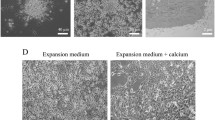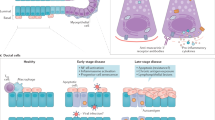Abstract
Primary Sjögren’s syndrome (pSS) is a chronic autoimmune disorder that particularly compromises the function of exocrine glands. The pathogenetic mechanisms of this autoimmune exocrinopathy have not been fully elucidated. Since increasing evidence actually suggests that the epidermal growth factor receptor (EGFR) pathway has a major impact on the inflammatory/immune reactions of the epithelial cells, in the apparent effort of enhancing innate immune defense while opposing overactivation of pro-inflammatory functions, the focus of the work presented here is clarify whether the EGFR–extracellular-signal-regulated kinase (ERK) pathway plays a role in the pro-inflammatory responses mounted by pSS salivary gland epithelial cells (SGEC). Investigations revealed that the EGFR-mediated activation of the downstream effectors ERK1/2 in pSS SGEC appeared to require ADAM17-dependent release of the endogenous EGFR ligand amphiregulin and transactivation of the EGFR. Moreover, blockade of amphiregulin bioactivity using a neutralizing Ab significantly reduced EGFR transactivation and ERK1/2 phosphorylation. In addition, pSS SGEC treated with the specific ADAM17 inhibitor TAPI-1 and with the EGFR inhibitor AG1478 exhibited deactivated AREG/EGFR/ERK signaling pathway and reduced pro-inflammatory cytokines released.





Similar content being viewed by others
References
Manoussakis MN, Kapsogeorgou EK (2010) The role of intrinsic epithelial activation in the pathogenesis of Sjogren’s syndrome. J Autoimmun 35:219–224
Mavragani CP, Nezos A, Moutsopoulos HM (2013) New advances in the classification, pathogenesis and treatment of Sjögren’s syndrome. Curr Opin Rheumatol 25:623–629
Manoussakis MN, Kapsogeorgou EK (2007) The role of epithelial cells in the pathogenesis of Sjogren’s syndrome. Clin Rev Allergy Immunol 32:225–230
Lisi S, Sisto M, D’Amore M, Lofrumento DD, Ribatti D (2013) Emerging avenues linking inflammation, angiogenesis and Sjögren’s syndrome. Cytokine 61:693–703
Kapsogeorgou EK, Dimitriou ID, Abu-Helu RF, Moutsopoulos HM, Manoussakis MN (2001) Activation of epithelial and myoepithelial cells in the salivary glands of patients with Sjögren’s syndrome: high expression of intercellular adhesion molecule-1 (ICAM1) in biopsy specimens and cultured cells. Clin Exp Immunol 124:126–133
Tzioufas AG, Kapsogeorgou EK, Moutsopoulos HM (2012) Pathogenesis of Sjögren’s syndrome: what we know and what we should learn. J Autoimmun 39:4–8
Sisto M, Lisi S, Lofrumento D, D’Amore M, Scagliusi P, Mitolo V (2007) Autoantibodies from Sjögren’s syndrome trigger apoptosis in salivary gland cell line. Ann N Y Acad Sci 1108:418–425
Sisto M, D’Amore M, Caprio S, Mitolo V, Scagliusi P, Lisi S (2009) Tumor necrosis factor inhibitors block apoptosis of human epithelial cells of the salivary glands. Ann N Y Acad Sci 1171:407–414
Scheller J, Chalaris A, Garbers C, Rose-John S (2011) ADAM17: a molecular switch to control inflammation and tissue regeneration. Trends Immunol 32:380–387
Sisto M, Lisi S, Lofrumento DD, Frassanito MA, Cucci L, D’Amore S, Mitolo V, D’Amore M (2009) Induction of TNF-alpha-converting enzyme-ectodomain shedding by pathogenic autoantibodies. Int Immunol 21:1341–1349
Lisi S, Sisto M (2010) Effects of biological drug adalimumab on tumour necrosis factor-alpha-converting enzyme activation. Immunol Cell Biol 88:297–304
Lisi S, Sisto M, Lofrumento DD, Cucci L, Frassanito MA, Mitolo V, D’Amore M (2010) Pro-inflammatory role of Anti-Ro/SSA autoantibodies through the activation of Furin-TACE-amphiregulin axis. J Autoimmun 35:160–170
Sisto M, Lisi S, Lofrumento DD, Ingravallo G, Mitolo V, D’Amore M (2010) Expression of pro-inflammatory TACE-TNF-α-amphiregulin axis in Sjögren’s syndrome salivary glands. Histochem Cell Biol 134:345–353
Lisi S, Sisto M, Lofrumento DD, D’Amore M (2012) Sjögren’s syndrome autoantibodies provoke changes in gene expression profiles of inflammatory cytokines triggering a pathway involving TACE/NF-κB. Lab Invest 92:615–624
Lisi S, Sisto M, Lofrumento DD, D’Amore M, De Lucro R, Ribatti D (2013) GRO-α/CXCR2 system and ADAM17 correlated expression in Sjögren’s syndrome. Inflammation 36:759–766
Black RA, Rauch CT, Kozlosky CJ, Peschon JJ, Slack JL, Wolfson MF, Castner BJ, Stocking KL, Reddy P, Srinivasan S, Nelson N, Boiani N, Schooley KA, Gerhart M, Davis R, Fitzner JN, Johnson RS, Paxton RJ, March CJ, Cerretti DP (1997) A metalloproteinase disintegrin that releases tumour-necrosis factor-α from cells. Nature 385:729
Lee DC, Sunnarborg SW, Hinkle CL, Myers TJ, Stevenson MY, Russell WE, Castner BJ, Gerhart MJ, Paxton RJ, Black RA, Chang A, Jackson LF (2003) TACE/ADAM17 processing of EGFR ligands indicates a role as a physiological convertase. Ann N Y Acad Sci 995:22–38
Marshall CJ (1995) Specificity of receptor tyrosine kinase signaling: transient versus sustained extracellular signal-regulated kinase activation. Cell 80:179–185
Wells A (1999) EGF receptor. Int J Biochem Cell Biol 31:637–643
Kyriakis JM, App H, Zhang XF, Banerjee P, Brautigan DL, Rapp UR, Avruch J (1992) Raf-1 activates MAP kinase–kinase. Nature 358:417–421
Borrell-Pagès M, Rojo F, Albanell J, Baselga J, Arribas J (2003) TACE is required for the activation of the EGFR by TGF-alpha in tumors. EMBO J 22:1114–1124
Vitali C, Bombardieri S, Jonsson R, Moutsopoulos HM, Alexander EL, Carsons SE, Daniels TE, Fox PC, Fox RI, Kassan SS, Pillemer SR, Talal N, Weisman MH, European Study Group on Classification Criteria for Sjögren’s Syndrome (2002) Classification criteria for Sjögren’s syndrome: a revised version of the European criteria proposed by the American-European Consensus Group. Ann Rheum Dis 61:554–558
Sens DA, Hintz DS, Rudisill MT, Sens MA, Spicer SS (1985) Explant culture of human submandibular gland epithelial cells: evidence for ductal origin. Lab Invest 52:559–567
Pastore S, Mascia F, Mariani V, Girolomoni G (2008) The epidermal growth factor receptor system in skin repair and inflammation. J Invest Dermatol 128:1365–1374
Zhao D, Zhan Y, Koon HW, Zeng H, Keates S, Moyer MP, Pothoulakis C (2004) Metalloproteinase-dependent transforming growth factor-release mediates neurotensin-stimulated MAP kinase activation in human colonic epithelial cells. J Biol Chem 279:43547–43554
Blobel CP (2005) ADAMs: key components in EGFR signalling and development. Nat Rev Mol Cell Biol 6:32–43
Fischer OM, Hart S, Gschwind A, Ullrich A (2003) EGFR signal transactivation in cancer cells. Biochem Soc Trans 31:1203–1208
Hinkle CL, Sunnarborg SW, Loiselle D, Parker CE, Stevenson M, Russell WE, Lee DC (2004) Selective roles for tumor necrosis factor alpha-converting enzyme/ADAM17 in the shedding of the epidermal growth factor receptor ligand family: the juxtamembrane stalk determines cleavage efficiency. J Biol Chem 279:24179–24188
Chokki M, Mitsuhashi H, Kamimura T (2006) Metalloprotease-dependent amphiregulin release mediates tumor necrosis factor-alpha-induced IL-8 secretion in the human airway epithelial cell line NCI-H292. Life Sci 78:3051–3057
Wang ZQ, Wu DC, Huang FP, Yang GY (2004) Inhibition of MEK/ERK 1/2 pathway reduces pro-inflammatory cytokine interleukin-1 expression in focal cerebral ischemia. Brain Res 996:55–66
Foey AD, Parry SL, Williams LM, Feldmann M, Foxwell BM, Brennan FM (1998) Regulation of monocyte IL-10 synthesis by endogenous IL-1 and TNF-alpha: role of the p38 and p42/44 mitogen-activated protein kinases. J Immunol 160:920–928
Saklatvala J, Rawlinson LM, Marshall CJ, Kracht M (1993) Interleukin 1 and tumour necrosis factor activate the mitogen-activated protein (MAP) kinase kinase in cultured cells. FEBS Lett 334:189–192
Schlessinger J (2000) Cell signaling by receptor tyrosine kinases. Cell 103:211–225
Wetzker R, Böhmer FD (2003) Transactivation joins multiple tracks to the ERK/MAPK cascade. Nat Rev Mol Cell Biol 4:651–657
Stoll SW, Johnson JL, Bhasin A, Johnston A, Gudjonsson JE, Rittié L, Elder JT (2010) Metalloproteinase-mediated, context-dependent function of amphiregulin and HB-EGF in human keratinocytes and skin. J Invest Dermatol 130:295–304
Berasain C, Nicou A, Garcia-Irigoyen O, Latasa MU, Urtasun R, Elizalde M, Salis F, Perugorría MJ, Prieto J, Recio JA, Corrales FJ, Avila MA (2012) Epidermal growth factor receptor signalling in hepatocellular carcinoma: inflammatory activation and a new intracellular regulatory mechanism. Dig Dis 30:524–531
Leserer M, Gschwind A, Ullrich A (2000) Epidermal growth factor receptor signal transactivation. IUBMB Life 49:405–409
Doedens JR, Mahimkar RM, Black RA (2003) TACE/ADAM-17 enzymatic activity is increased in response to cellular stimulation. Biochem Biophys Res Commun 308:331–338
Gooz M (2010) ADAM-17: the enzyme that does it all. Crit Rev Biochem Mol Biol 45:146–169
Keates S, Han X, Kelly CP, Keates AC (2007) Macrophage-inflammatory protein-3alpha mediates epidermal growth factor receptor transactivation and ERK1/2 MAPK signaling in Caco-2 colonic epithelial cells via metalloproteinase-dependent release of amphiregulin. J Immunol 178:8013–8021
Sawalha AH, Jeffries M, Webb R, Lu Q, Gorelik G, Ray D, Osban J, Knowlton N, Johnson K, Richardson B (2008) Defective T-cell ERK signalling induces interferon-regulated gene expression and overexpression of methylation-sensitive genes similar to lupus patients. Genes Immun 9:368–378
Singh K, Deshpande P, Pryshchep S, Colmegna I, Liarski V, Weyand CM (2009) ERK-dependent T cell receptor threshold calibration in rheumatoid arthritis. J Immunol 183:8258–8267
Mascia F, Mariani V, Girolomoni G, Pastore S (2003) Blockade of the EGF receptor induces a deranged chemokine expression in keratinocytes leading to enhanced skin inflammation. Am J Pathol 163:303–312
Acknowledgments
We are grateful to M.V.C. Pragnell, B.A., a professional text editor, who revised and edited for English language the manuscript.
Conflict of interest
We do not have any conflicts of interest to declare.
Author information
Authors and Affiliations
Corresponding author
Additional information
Margherita Sisto and Sabrina Lisi have equal contribution in this work and both are equally considered as “first author”.
Rights and permissions
About this article
Cite this article
Sisto, M., Lisi, S., D’Amore, M. et al. The metalloproteinase ADAM17 and the epidermal growth factor receptor (EGFR) signaling drive the inflammatory epithelial response in Sjögren’s syndrome. Clin Exp Med 15, 215–225 (2015). https://doi.org/10.1007/s10238-014-0279-4
Received:
Accepted:
Published:
Issue Date:
DOI: https://doi.org/10.1007/s10238-014-0279-4




